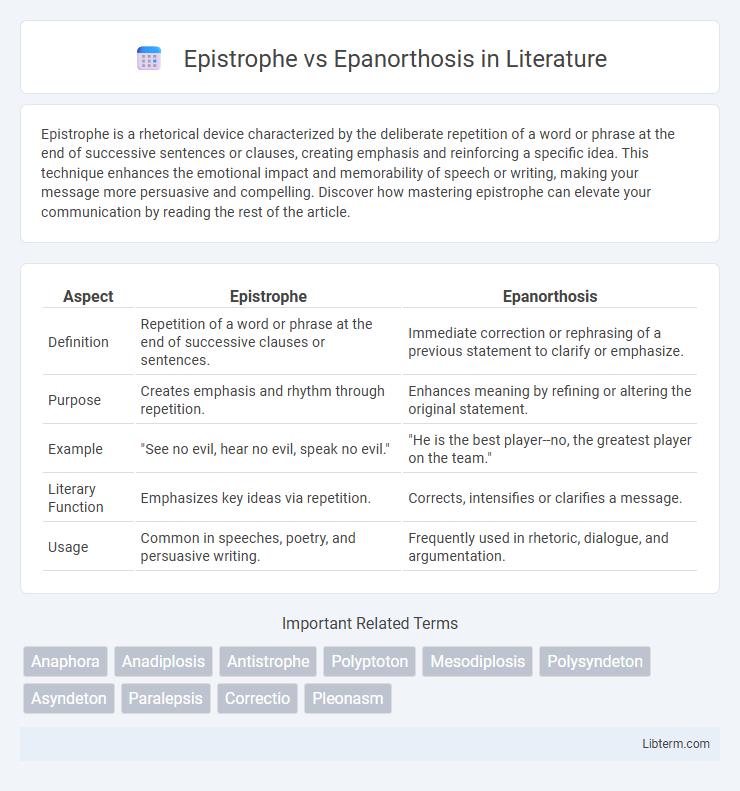Epistrophe is a rhetorical device characterized by the deliberate repetition of a word or phrase at the end of successive sentences or clauses, creating emphasis and reinforcing a specific idea. This technique enhances the emotional impact and memorability of speech or writing, making your message more persuasive and compelling. Discover how mastering epistrophe can elevate your communication by reading the rest of the article.
Table of Comparison
| Aspect | Epistrophe | Epanorthosis |
|---|---|---|
| Definition | Repetition of a word or phrase at the end of successive clauses or sentences. | Immediate correction or rephrasing of a previous statement to clarify or emphasize. |
| Purpose | Creates emphasis and rhythm through repetition. | Enhances meaning by refining or altering the original statement. |
| Example | "See no evil, hear no evil, speak no evil." | "He is the best player--no, the greatest player on the team." |
| Literary Function | Emphasizes key ideas via repetition. | Corrects, intensifies or clarifies a message. |
| Usage | Common in speeches, poetry, and persuasive writing. | Frequently used in rhetoric, dialogue, and argumentation. |
Introduction to Epistrophe and Epanorthosis
Epistrophe is a rhetorical device characterized by the deliberate repetition of a word or phrase at the end of successive clauses or sentences, enhancing emphasis and rhythm. Epanorthosis involves immediate self-correction or rephrasing within a sentence to clarify or strengthen the speaker's point, often highlighting an afterthought or refinement. Both devices serve to influence the audience's perception by reinforcing ideas through repetition or precision in expression.
Defining Epistrophe: A Rhetorical Device
Epistrophe, a rhetorical device, involves the deliberate repetition of a word or phrase at the end of successive clauses or sentences, enhancing emphasis and memorability in speech or writing. This technique contrasts with epanorthosis, which entails immediate self-correction or clarification within a sentence to refine or strengthen meaning. Epistrophe's strategic repetition can evoke emotional resonance and reinforce key themes, making it a powerful tool in persuasive communication.
Understanding Epanorthosis: Clarifying the Concept
Epanorthosis involves the immediate correction or rephrasing of a statement to clarify or strengthen the intended meaning, often enhancing precision in communication. Unlike epistrophe, which repeats words or phrases at the end of successive clauses for emphasis, epanorthosis disrupts the flow by revising the previous expression. This rhetorical device is essential for writers and speakers aiming to refine their arguments and clarify complex ideas.
Structural Differences: Epistrophe vs Epanorthosis
Epistrophe is a rhetorical device characterized by the repetition of a word or phrase at the end of successive clauses or sentences, creating emphasis through structural symmetry. Epanorthosis involves immediate self-correction within a sentence, where the speaker retracts and reformulates their previous statement to clarify or intensify meaning. While epistrophe relies on repetitive endings to enhance rhythm and memorability, epanorthosis disrupts progression by interjecting a corrective phrase, altering the original statement's structure for precision or rhetorical effect.
Purpose and Effects in Rhetoric
Epistrophe employs repetition of words or phrases at the end of successive sentences to reinforce a concept and create a memorable rhythm, enhancing emotional impact and persuasive power. Epanorthosis, on the other hand, involves immediate self-correction or rephrasing to clarify meaning or intensify an argument, emphasizing the speaker's precision and urgency. Both devices strengthen rhetorical effectiveness by either solidifying key ideas through repetition or refining statements to engage and persuade the audience more effectively.
Famous Examples in Literature
Epistrophe, the repetition of a word or phrase at the end of successive clauses, is famously illustrated in Abraham Lincoln's Gettysburg Address with "of the people, by the people, for the people." Epanorthosis, a self-correction strategy where a speaker immediately revises a statement, appears in Shakespeare's "Hamlet" when Hamlet says, "I am too much i' the sun--too much." Both rhetorical devices enhance emphasis and clarity, demonstrating powerful stylistic choices in classical literature.
Usage in Modern Speech and Writing
Epistrophe, the repetition of a word or phrase at the end of successive clauses, enhances emphasis and rhythm in modern speech and persuasive writing, often found in political speeches and poetry to reinforce a key idea. Epanorthosis involves immediate self-correction or clarification within a sentence, commonly used in conversational speech, writing, and rhetoric to refine statements, convey precision, or express hesitation. Both figures of speech serve distinct roles: epistrophe intensifies impact through repetition, while epanorthosis improves clarity and demonstrates the speaker's or writer's reflective process.
How to Distinguish Epistrophe from Epanorthosis
Epistrophe is the repetition of a word or phrase at the end of successive clauses or sentences, creating emphasis through rhythmic reinforcement in rhetoric. Epanorthosis involves immediate correction or rephrasing of a previous statement to clarify or intensify meaning, often altering the initial claim for precision. To distinguish epistrophe from epanorthosis, identify epistrophe by its deliberate ending repetition, while epanorthosis is characterized by its self-corrective or adjusting nature within a single utterance.
Common Misconceptions and Pitfalls
Epistrophe often gets confused with anaphora, but it specifically involves the repetition of words at the end of successive clauses, whereas epanorthosis is a self-corrective rhetorical device where a speaker retracts or amends a previous statement for clarity or impact. A common misconception is treating epanorthosis as mere hesitation, when it actually strengthens argumentation by refining or intensifying the message. Pitfalls include misidentifying these techniques in speeches or texts, leading to weakened rhetorical analysis and misunderstanding the speaker's intent.
Practical Tips for Writers and Speakers
Epistrophe, the deliberate repetition of a word or phrase at the end of successive sentences, enhances emphasis and rhythm, making key ideas more memorable in speech or writing. Epanorthosis involves immediately correcting or rephrasing a previous statement, which can clarify intentions and add a persuasive or dramatic effect. Writers and speakers can effectively use epistrophe to reinforce important points, while epanorthosis serves to provide precision and engage the audience through a dynamic, conversational tone.
Epistrophe Infographic

 libterm.com
libterm.com